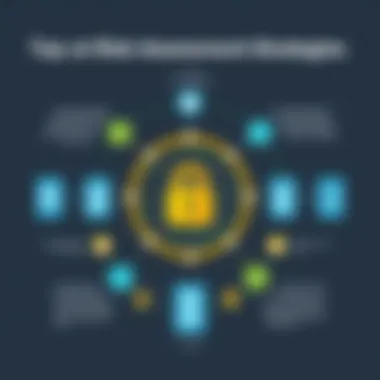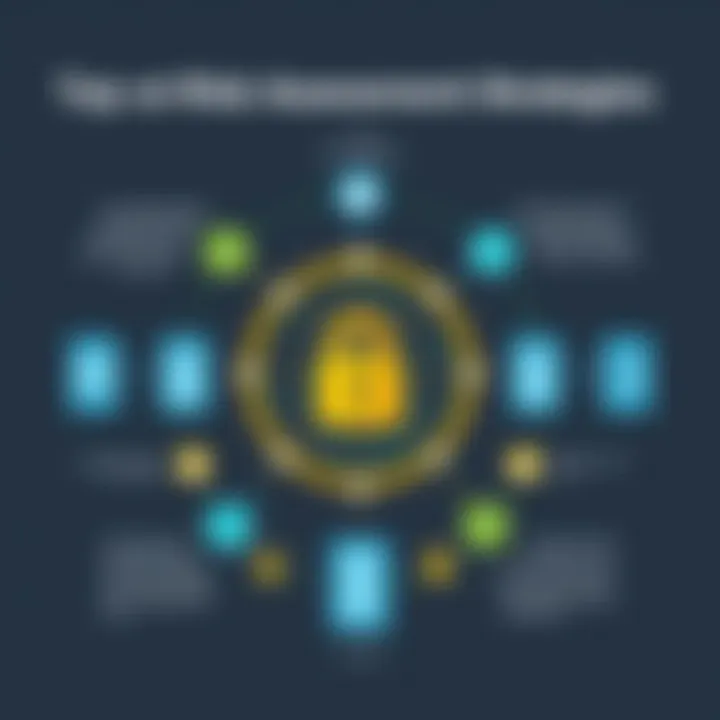Essential Strategies for Website Security in 2023


Intro
In this age of digitalization, where information is just a click away, the security of websites has become more crucial than ever. The vast and often tumultuous waters of the internet harbor various threats, from malicious software to data breaches. A solid website security framework is not merely a nice-to-have but rather a necessity for businesses aiming to protect their digital assets and customer data. Hence, understanding the nuances of website security is paramount, not only for IT personnel but also for decision-makers and entrepreneurs.
In this comprehensive guide, we delve into the vital aspects of website security, dissecting essential practices, risk assessments, and current technologies that form the backbone of effective cybersecurity. We will also explore trends that are shaping the future for better protection schemes. As organizations look to safeguard their digital presence, being armed with the right information will enable them to navigate the cybersecurity landscape adeptly.
Key Features and Functionalities
Comprehensive Overview
Website security encompasses a wide array of protocols and technologies designed to protect against numerous threats. It’s not just about installing firewalls or antivirus software; it requires a holistic approach involving various layers of defense.
To better illustrate, here are some key features that effective website security solutions often include:
- SSL Certificates: Security Sockets Layer certificates encrypt data transmitted between the user’s browser and your website, ensuring confidentiality and integrity.
- Web Application Firewalls (WAF): These act as a barrier, filtering and monitoring traffic between your website and the internet to block harmful requests.
- Regular Software Updates: Keeping software up-to-date prevents exploits that target known vulnerabilities.
- Backup Solutions: Regular backups ensure that data isn’t lost in the event of a breach or system failure.
- DDoS Protection: Distributed Denial-of-Service attacks can cripple a website; specialized services can mitigate these attacks by absorbing excess traffic.
Adopting a blend of these features results in a robust defense strategy against the ever-evolving threats online.
Target Users
So who needs to pay attention to website security? The answer is everyone—from small startups to large enterprises. Here’s the breakdown of target users:
- Entrepreneurs: Small business owners often underestimate the need for security, yet they are prime targets due to inadequate protection.
- IT Professionals: These individuals need comprehensive knowledge to implement security best practices and manage threats effectively.
- Advisors in the Cybersecurity Space: Professionals guiding organizations must stay current on trends and best methods in safeguarding digital infrastructure.
- C-Suite Executives: Leaders who make strategic decisions about technology investments must understand the implications and benefits of robust security practices.
With the right understanding and tools, these target users can create a fortress around their digital properties, thus ensuring both safety and trust.
"A strong defense is the best offense in the ever-changing game of website security."
Resources for further details:
Foreword to Website Security
In today's digital age, where information flows freely and interactions happen at the speed of light, the significance of website security cannot be overstated. For businesses and individuals alike, ensuring that their online platforms remain secure is not just a precaution, it's a necessity. When a website is compromised, the repercussions can be dire, affecting not only the integrity of data but also the credibility of the brand involved. Thus, a meticulous approach to understanding the facets of website security becomes essential.
The Importance of Website Security
Website security serves as a bulwark against the myriad threats that can jeopardize sensitive information and undermine user trust. As more transactions shift online, the stakes have climbed. A breach could lead to financial losses, legal repercussions, and the tarnishing of one's reputation. For instance, consider a retail website that experiences a data breach; the fallout not only involves financial loss through fraudulent transactions but also potential loss of customer loyalty, which can resonate for years.
Moreover, implementing solid security measures can act as a selling point. Many consumers today are keenly aware of their privacy and data rights. Businesses that demonstrate a commitment to securing their websites can attract more customers. This perceived reliability can ultimately translate into increased sales and enhanced customer relationships.


Furthermore, the landscape of cyber threats is constantly evolving. With hackers constantly innovating new techniques, staying ahead of them demands an ongoing commitment to security updates, training, and adopting best practices. Incorporating robust security measures from the outset can mitigate the risks that come with such complexity.
In essence, the importance of website security extends beyond mere compliance with regulations. It instills confidence in users and provides a sense of safety when engaging online. Hence, understanding the depth of the topic is crucial for any organization aiming to stand the test of time in the digital realm.
Common Security Threats
The myriad threats that challenge website security can seem overwhelming, but recognizing them is the first step towards effective defense. Here are some of the most prevalent threats:
- SQL Injection: This occurs when an attacker can send malicious code to manipulate the database system, potentially gaining access to sensitive data.
- Cross-Site Scripting (XSS): XSS attacks allow an attacker to inject malicious scripts into content that others will view. This can lead to session hijacking or redirecting users to malicious sites.
- Distributed Denial of Service (DDoS): This type of attack overwhelms a server with traffic, causing it to crash and become unusable.
- Malware: Placing malicious software on websites can lead to unauthorized access and data theft.
- Phishing: Though more common through direct email, phishing can also manifest through compromised websites that mimic legitimate sites to steal credentials.
By understanding these threats, businesses can begin formulating strategies to combat them. Keeping a finger on the pulse of these issues, regularly educating staff, and investing in robust security measures can help ward off these risks. Ignoring them can lead to severe consequences.
"In this interconnected world, neglecting website security is tantamount to leaving the front door wide open for intruders."
In sum, website security is crucial not only for protecting data but also for fostering trust in an increasingly digital marketplace. As we delve deeper into the elements of cybersecurity, it becomes clear that the foundation of a secure digital presence is unwavering vigilance and continuous improvement.
Understanding Cybersecurity Frameworks
Cybersecurity frameworks play a crucial role in the broader context of website security. They act as blueprints, guiding organizations in the establishment of robust security measures. Such frameworks encapsulate a series of best practices, standards, and methodologies that are essential for protecting digital assets against the growing plethora of cyber threats.
The importance of understanding these frameworks lies not merely in their definitions but in their practical applications. By aligning organizational policies with established frameworks, stakeholders can gain clarity in their cybersecurity strategy. This clarity translates into tangible benefits such as improved risk management, enhanced incident response, and compliance with various regulations that govern data protection and privacy.
As cyber threats evolve in sophistication, relying solely on reactive measures is like trying to patch a leaky boat while out at sea. Instead, a proactive approach through a security framework lays down the foundation for a well-rounded defense strategy. This proactive stance not only strengthens resilience against threats but also builds trust with customers and partners.
Framework Overview
A cybersecurity framework usually comprises several foundational components. These include:
- Identification – Recognizing all essential assets and understanding potential risks associated with them.
- Protection – Implementing measures to guard against those identified risks, such as encryption and access controls.
- Detection – Establishing mechanisms to identify incidents when they occur, including monitoring systems for unusual activity.
- Response – Crafting a robust incident response plan that outlines actions to be taken in case of a security breach.
- Recovery – Ensuring that procedures are in place to restore normal operations following an incident.
Each component plays a vital role in a holistic approach to cybersecurity. By having a clear framework, organizations can systematically assess their security posture and address gaps that might expose them to vulnerabilities.
Adopting a Security Framework
Implementing a cybersecurity framework is not merely an operational task; it is strategic in nature and requires commitment from all levels of an organization. Decision-makers must first conduct assessments to determine which framework best meets their needs. The choices might include well-known frameworks such as the NIST Cybersecurity Framework, the ISO/IEC 27001, or the CIS Controls, each offering unique strengths based on the specific context.
Once a suitable framework is chosen, the next step involves a thorough integration of its principles into the organization’s culture. This includes:
- Conducting regular training sessions for employees to create awareness about security best practices.
- Continuous evaluation and updating of security measures to counter emerging threats effectively.
- Establishing a feedback loop from all areas of the organization to refine policies and practices based on real-world experiences.
Maintaining a security framework is an ongoing commitment. As technologies advance and threat landscapes shift, revisiting and iterating on the framework becomes necessary. The result is a dynamic approach to cybersecurity that evolves alongside the organization and the environment it operates in.


In the realm of cybersecurity, staying static defies the very essence of what it aims to protect.
By proficiently adopting a framework, organizations not only mitigate the risk of data breaches but also position themselves as responsible digital citizens in an increasingly interconnected world.
Website Vulnerabilities and Threats
In today’s digital age, the existence of vulnerabilities and threats to websites cannot be overstated. Understanding these vulnerabilities is paramount for anyone looking to fortify their online presence. As businesses increasingly shift operations online, grabbing visibility and maintaining trust with customers necessitates an intricate grasp of potential threats. Failure to address these vulnerabilities can lead to significant financial and reputational damage.
The world of website security is akin to navigating a minefield. One misstep can trigger a reaction that devastates one's digital assets. Thus, identifying common vulnerabilities becomes crucial, enabling organizations to put protective measures in place before calamity strikes. This not only shields sensitive data but also assures clients that their information remains safe.
Exploring Common Vulnerabilities
Common vulnerabilities lurk in multiple layers of web applications, sometimes hiding in plain sight. Here are a few widely recognized examples:
- SQL Injection: A prevalent method where attackers send malicious SQL statements to exploit vulnerabilities in a website's database. If a site doesn’t adequately sanitize user inputs, attackers may gain an entry point to sensitive data, resulting in dire consequences.
- Cross-Site Scripting (XSS): This type of vulnerability allows attackers to inject scripts into web pages viewed by users. As a consequence, unsuspecting users may unwittingly execute these scripts, leading to stolen credentials or other damaging outcomes.
- Cross-Site Request Forgery (CSRF): CSRF attacks trick users into executing unwanted actions on a different site where they are authenticated. It takes advantage of the user’s credentialed session and can lead to unauthorized transactions.
Organizations must conduct routine vulnerability assessments to discover such issues before they can be exploited. Tools like OWASP ZAP and Nessus can be instrumental in this regard, providing extensive insight into exposed vulnerabilities.
Analyzing Attack Vectors
Elements of attack vectors determine how an adversary approaches vulnerabilities. Understanding this can dramatically improve a website’s resilience against threats.
- User Input Fields: These are common entry points where an attacker might inject malicious scripts or code. Comprehensive input validation is paramount to mitigate risks associated with user-generated content.
- APIs: Application Programming Interfaces serve as critical communication routes for web applications. However, if not meticulously managed and secured, they can expose sensitive data and functions.
- Third-Party Integrations: Many businesses use plugins or services from outside sources to enhance functionality. Although they provide benefits, they might introduce vulnerabilities that can be leveraged by attackers.
"Identifying attack vectors is like assembling a puzzle. Each piece needs to fit perfectly to understand the bigger picture of cybersecurity."
Enhancing website security requires a holistic view of how different components interact. By identifying potential attack vectors, businesses can better prepare themselves against the unpredictable landscape of cyber threats. Regular monitoring and vigilance can help ensure the integrity and availability of web applications, maintaining customer trust and safeguarding valuable assets.
Risk Assessment and Management
Risk assessment and management lay the foundation for a robust website security strategy. In a world where digital threats loom larger by the day, understanding vulnerabilities and enhancing protective measures becomes paramount for organizations of all sizes. This element of security is not just a checkbox in compliance metrics; it’s a continuous cycle of identifying risks, reviewing processes, and implementing improvements that can save a business’s reputation, finances, and vast amounts of stressful time. Here, we will dig into the nuances of conducting risk assessments and the strategies that can be employed to mitigate those risks effectively.
Conducting Risk Assessments
Embarking on the journey of conducting risk assessments requires a meticulous approach, akin to navigating through a minefield. It’s essential to pinpoint the weaknesses that might expose sensitive data or lead to significant breaches.
- Identifying Assets: The first step is to catalog all assets such as databases, server interfaces, user accounts, and any third-party services employed by the organization. Understanding what these assets are and their importance will provide a clearer picture of what needs protection.
- Identifying Threats and Vulnerabilities: After mapping out the assets, the next logical step is to brainstorm potential threats. This might include cybercriminals looking to exploit weaknesses, natural disasters that could disrupt services, or even insider threats due to disgruntled employees. Making use of tools and frameworks, such as OCTAVE or NIST, can be extremely helpful in identifying where vulnerabilities lie.
- Assessing Impact and Likelihood: Each identified risk should then be evaluated in terms of its potential impact and likelihood of occurrence. Using a scale from low to high often works well. A risk that is likely to occur with substantial impact warrants immediate attention, while a low-likelihood risk may simply require monitoring.
- Documenting Findings: This phase is crucial—documenting the findings will help in creating a base reference point for improvement. Maintaining a risk register can help organizations keep track of regulated vulnerabilities, identified threats, and risk mitigation measures underway.
"You can't manage what you don't measure." - This saying rings true in the world of risk assessment. Without proper documentation, assessing progress over time becomes nearly impossible.
Mitigation Strategies


Once risks have been assessed and documented, it is time to brainstorm actionable mitigation strategies. Each strategy should be rooted in practicality while considering the overall budget and available resources. Here are some common approaches to keep in mind:
- Implementing Technical Controls: Establish firewalls, intrusion detection systems, and malware protection. These technical barriers serve as the first line of defense against many potential threats.
- Training Employees: Human error can lead to security lapses, so education plays a key role. Regular training sessions that focus on security protocols and phishing awareness can significantly reduce the risks associated with human error.
- Regular Audits and Updates: It’s crucial to regularly audit security practices and update methods and technologies. Cybersecurity is a moving target, and being proactive rather than reactive helps in staying ahead.
- Develop Incident Response Plans: Just as one prepares for a rainy day, having an incident response plan outlines the steps to take once a security breach occurs. This should include aspects like how to communicate with stakeholders, what technical processes to initiate, and how to assess damage.
By keeping these strategies in mind, organizations can create a robust safety net that allows for more confidence in their digital operations. As the digital landscape continues to evolve, so too should the methods and strategies employed to secure it, making risk assessment and management a priority for every stakeholder involved.
Further information on these processes can be found on resources such as NIST's Cybersecurity Framework or the special cybersecurity publications available through SCAP.
Essential Website Security Technologies
In today's fast-paced digital environment, the importance of employing robust website security technologies cannot be overstated. Cyber threats are becoming increasingly sophisticated, often evolving in ways that take advantage of both human and technical vulnerabilities. Organizations of all sizes must recognize that neglecting these security technologies could be tantamount to leaving the front door wide open for potential attackers.
Utilizing the right security technologies not only safeguards valuable data but also instills trust among users and clients. Implementing these tools can keep malicious activity at bay and provide peace of mind for businesses heavily reliant on online platforms.
===
Firewalls and Intrusion Detection Systems
Firewalls and Intrusion Detection Systems, or IDS, serve as the first line of defense against unauthorized access and suspicious activity. A firewall acts like a gatekeeper, controlling incoming and outgoing network traffic based on predetermined security rules. They're crucial in that they help block malicious traffic from entering the network. Additionally, they can be configured to filter potentially harmful content, providing an essential layer of defense.
On top of that, Intrusion Detection Systems monitor network traffic for suspicious activity. They scrutinize data patterns to detect anomalies or threats that bypass traditional firewalls. If a security breach is detected, the IDS can trigger alerts to notify IT administrators, allowing for rapid remediation. This two-pronged approach can significantly augment a website's security posture.
"Firewalls are the metaphorical fences we build, and Intrusion Detection Systems are our watchmen—both essential in guarding our digital assets."
There are different types of firewalls—network firewalls, application firewalls, and next-generation firewalls—each serving a specific purpose depending on the complexity of the network environment. For instance, a retailer handling sensitive customer information would prioritize more robust firewalls than a casual blogging website. Therefore, carefully assessing your needs is vital in selecting the right combination of defenses.
===
Encryption Protocols
Encryption protocols play a crucial role in transforming sensitive data into an unreadable format, ensuring that even if it is intercepted, it remains protected from unauthorized access. Every user input—be it passwords, credit card details, or personal information—should be securely encrypted. The most common standard is Transport Layer Security (TLS), which not only encrypts the data in transit but also provides authentication of the communicating parties.
It is also wise to implement end-to-end encryption for particularly sensitive interactions. This ensures that data is not only encrypted during transmission but also secure while at rest, thereby making it more difficult for attackers to retrieve meaningful information even if they manage to breach the network.
The implementation of SSL certificates is a straightforward way to initiate encryption protocols. Users are often reassured by the presence of "HTTPS" in their browser's address bar, as it signifies a secure connection. Neglecting encryption can send the wrong message to users and may result in data leaks or breaches that can tarnish a brand’s reputation.
===
Content Security Policy (CSP)
Content Security Policy, or CSP, serves as a proactive measure against cross-site scripting (XSS) and other code injection attacks. A CSP acts as an additional layer of security by specifying which content sources are trusted, helping to prevent various forms of attacks that target users through injecting malicious scripts into web pages.
By defining a strict policy, site administrators can whitelist certain content sources—like approved scripts, images, and stylesheets—while blocking everything else. This significantly minimizes the risk of tampering and ensures that only verified content is executed.
For example, a website may implement a CSP like:
plaintext Content-Security-Policy: default-src 'self'; img-src https://trusted-image-source.com;















